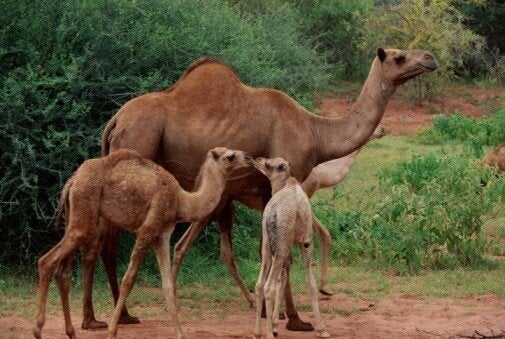
Got milk? Got camel milk? I didn't think so.
Although camel milk has a taste that's worth acquiring, it is unlikely that people will be splashing it on their cornflakes. But for those who need it, this is a natural, sustainable way to a healthier life. Speaking as someone who has tasted it both cool and pasteurized and frothy and warm direct from the teat -- after a few glugs it's downright delicious.
Right now in the U.S. the only people who can get hold of the milk 'a la mode' are 14 Amish camel dairies and the few parents who have demanded the dromedary juice as a treatment for their autistic child.
"Milk is money" according to The United Nations Food and Agriculture Organization (FAO) dairy and meat expert Anthony Bennett. But the cow dairy industry need not fear. After years of being on the market goat's milk is still a relatively novel product so as a commercial venture camel's milk hasn't got a chance. However, it is gaining ground as a health product, inspired by a litany of claims that punch above the pedestrian cow.
Camel milk is the closest you can get to a human mother's milk, with 10 times more iron and three times more vitamin C than cow's milk. It is antibacterial and low in lactose. Used medicinally by nomadic communities for centuries, fermented camel's milk is still popular in Kazakhstan as a treatment for Tuberculosis and for HIV/AIDS in Kenya and Somalia. Research has been conducted into treating Crohn's disease, breast cancer and autism, however the most promising studies have been in the field of diabetes.
While almost impossible to make camel milk into cheese, this is good news for diabetes sufferers. Dr. Agrawal of the Bikaner Diabetes Care and Research Centre explains, "We have demonstrated that the consumption of camel milk in type I diabetes results in a significant reduction in the dose of insulin required to maintain long-term glycemic control." Whilst the 2005 study maintained that insulin therapy is still the best option, in cases of needle phobia or in countries where the cost of treatment demands an alternative, just 500ml of raw fresh camel's milk daily improves quality of life. This is due to a protein found in camel milk with characteristics similar to insulin that does not coagulate as is the case with cow and goat milk. The camel milk protein passes rapidly through the stomach into the intestines for absorption.
So will this magical milk be reaching supermarket shelves any time soon?
Despite having the potential to help anemic mothers and feed newborn babies, as well as improve the lives of those living with HIV/AIDS, diabetes and autism, this is an unlikely step for the FDA to take. Speaking to Dr. Millie Hinkle of Camel Milk USA, it is clear that there is still a long way to go. "The camel industry in the U.S. is in a mess quite frankly. I have spent every penny that I have. I have even sold my wedding ring and all the furniture out of my house to help pay for test kits so that milk can be sold in stores. The FDA has refused to pay for the lab results and they say that they are overworked and understaffed. To get the milk ready for the market I will have to pay for everything myself or the camel people will," says Dr. Hinkle
It's an oft-heard story; without commercial viability the health benefits alone aren't worth the money or the research.
It is a different story in Dubai, where Martin van Almsick, of camel milk chocolate producer Al-Nassma, has high hopes: "In Sudan we are looking at about four million animals, which means camel liver restaurants -- raw with lime and onions, very delicious -- and a new chain of raw camel milk shops."